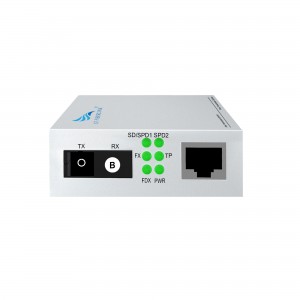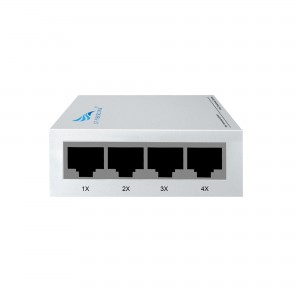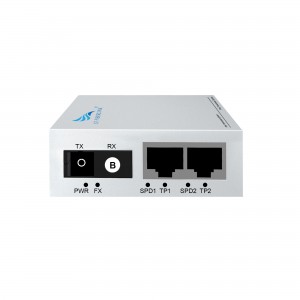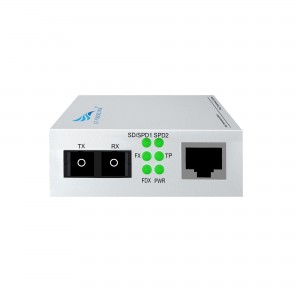3-port 10/100M Media Converter (Single-mode Dual-fiber SC)
3-port 10/100M Media Converter (Single-mode Dual-fiber SC)
Product Features:
Introducing the Optical Single Mode Dual Fiber Converter – The Ultimate Solution for Seamless Communication!
Huizhou Changfei Optoelectronics Technology Co., Ltd. is a leading communication equipment manufacturer focusing on cutting-edge technology, and we are proud of it. With a state-of-the-art production base covering an area of more than 20,000 square meters and a highly skilled R&D team of more than 30 professionals, we are committed to providing innovative and reliable solutions to global customers.
Our optoelectronic single-mode to dual-fiber converters are an outstanding addition to our extensive range of communications products. Specifically designed to meet a variety of industrial needs, the converter combines the advantages of optical and electrical transmission to ensure unrivaled performance and reliability.
This versatile device supports Ethernet and fiber conversion, making it ideal for industrial applications. Whether you need Ethernet fiber optic converters or multimode fiber optic transceivers, our optoelectronic singlemode dual fiber optic converters can meet your needs.
The converter features a robust iron housing design and an IP30 rating for exceptional durability and optimum protection against external elements. This ensures uninterrupted communication even in harsh working environments.
With the ability to operate on external power supplies, our converters offer flexibility and convenience. This feature allows for easy installation and maintenance, eliminating unnecessary downtime.
As an innovative high-tech enterprise, we know the importance of reliable and efficient communication equipment for enterprises. That’s why we’ve crafted optical-to-optical single-mode to dual-fiber converters to meet all your networking needs.
By choosing our products, you can benefit from seamless and secure data transmission no matter how complex your network infrastructure is. With our converters, you can experience enhanced network performance, increased productivity and reduced operating costs.
Whether you need a reliable connection for a small office setup or an extensive industrial network, our converters can meet your specific requirements. Our expert team is dedicated to providing first-class technical support and guidance to ensure smooth installation and operation.
At Huizhou Changfei Photoelectric Technology Co., Ltd., we put customer satisfaction first. Our dedication to providing superior products coupled with unparalleled customer service has earned us an excellent reputation in the industry.
In summary, our optoelectronic single-mode dual-fiber converters are the ultimate solution for seamless communication in industrial environments. With its iron case design, IP30 protection rating and external power supply, the converter offers outstanding durability and convenience.
What This Product Does
◇ The CF-1022SW-20 is a media converter designed to convert 100BASE-FX fiber to 100Base-TX copper media or vice versa. Designed under IEEE 802.3u 10/100Base-TX and 100Base-FX standards, the CF-1022SW-20 is designed for use with single-mode fiber cable utilizing the SC-Type connector. The CF-1022SW-20 supports longwave (LX) laser specification at a full wire speed forwarding rate. It works at 1310nm on both transmitting and receiving data.
◇ Other features of this module include the ability to be used as a stand alone device (no chassis required), Auto MDI/MDI-X for TX port, and front panel status LEDs. The CF-1022SW-20 will transmit at extended fiber optic distances utilizing single-mode fiber up to 20 kilometers.
Other Features
◇ Besides, this media converter can be used as a standalone device (no rack required) or used with CF FIBERLINK’s CF-2U14 rack for auto MDI/MDI-X in TX port in which duplex mode is automatically negotiated.
Experience the power of a reliable network with our converters, backed by the expertise of Huizhou Changfei Optoelectronics Technology Co., Ltd. Contact us today and take your communication skills to the next level!
Technical Parameter:
|
Model |
CF-1022SW-20 | |
| Interface Characteristics | ||
|
Fixed Port |
2* 10/ 100Base-TX RJ45 port 1* 155M uplink SC fiber port |
|
|
Ethernet Port |
10/ 100Base-TX auto-sensing, full/half duplex MDI/MDI-X self-adaption |
|
|
Twisted Pair Transmission |
10BASE-T: Cat3,4,5 UTP(≤100 meter) 100BASE-T: Cat5e or later UTP(≤100 meter) |
|
| Optical Port | Default optical module is single-mode dual-fiber 20km, SC port | |
| Wavelength/Distance | single mode: 1310nm 0~40KM ,1550nm 0~120KM | |
| Chip Parameter | ||
| Network Protocol | IEEE802.3 10BASE-T, IEEE802.3i 10Base-T,
IEEE802.3u 100Base-TX, IEEE802.3u 100Base-FX, IEEE802.3x |
|
|
Forwarding Mode |
Store and Forward(Full Wire Speed) |
|
|
Switching Capacity |
0.6Gbps |
|
|
Buffer Memory |
0.45Mpps | |
|
MAC |
1K | |
|
LED Indicator |
Fiber | SD/SPD1 (green) |
| rate | SPD2: 10/ 100 (green) | |
| Data | FX(green)/TP (green) | |
| FDX (green) | ||
| Single / duplex | ||
| Power | PWR (green) | |
| Power | ||
| Working Voltage |
AC:100-240V |
|
|
Power Consumption |
Standby<1W, Full load<3W |
|
|
Power Supply |
DC:5V/2A industrial power supply |
|
| Lightning protection &Certification | ||
| Lightning protection | Lightning protection: 4KV 8/20us, Protection level: IP30 | |
| Certification | CCC;CE mark, commercial; CE/LVD EN60950;FCC Part 15 Class B; RoHS | |
| Physical Parameter | ||
| Operation TEMP | -20~+55°C;5%~90% RH Non condensing | |
| Storage TEMP |
-40~+85°C;5%~95% RH Non condensing |
|
| Dimension (L*W*H) | 94mm* 71mm*27mm | |
| Installation | Desktop, CF-2U14 slot rack | |
Product Size:
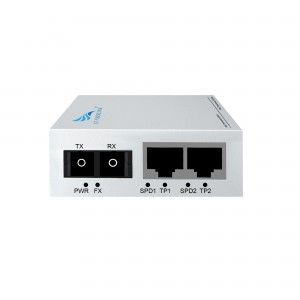
product application diagra:

How to choose a fiber optic transceiver?
Optical fiber transceivers break the 100-meter limitation of Ethernet cables in data transmission. Relying on high-performance switching chips and large-capacity caches, while truly achieving non-blocking transmission and switching performance, they also provide balanced traffic, isolation and conflict. Error detection and other functions ensure high security and stability during data transmission. Therefore, fiber optic transceiver products will still be an indispensable part of actual network construction for a long time. So, how should we choose fiber optic transceivers?
1. Port function test
Mainly test whether each port can work normally in the duplex state of 10Mbps, 100Mbps and half-duplex state. At the same time, it should be tested whether each port can automatically select the highest transmission speed and automatically match the transmission rate of other devices. This test can be included in other tests.
2. Compatibility test
It mainly tests the connection ability between the optical fiber transceiver and other devices compatible with Ethernet and Fast Ethernet (including network card, HUB, Switch, optical network card, and optical switch). The requirement must be able to support the connection of compatible products.
3. Cable connection characteristics
Test the fiber optic transceiver’s ability to support network cables. First, test the connection ability of Category 5 network cables with lengths of 100m and 10m, and test the connection ability of long Category 5 network cables (120m) of different brands. During the test, the optical port of the transceiver is required to have a connection capability of 10Mbps and a rate of 100Mbps, and the highest must be able to connect to a full-duplex 100Mbps without transmission errors. Category 3 twisted pair cables may not be tested. Subtests can be included in other tests.
4. Transmission characteristics (transmission loss rate of data packets of different lengths, transmission speed)
It mainly tests the packet loss rate when the optical fiber transceiver optical port transmits different data packets, and the connection speed under different connection rates. For the packet loss rate, you can use the test software provided by the network card to test the packet loss rate when the packet size is 64, 512, 1518, 128 (optional) and 1000 (optional) bytes under different connection rates. , the number of packet errors, the number of packets sent and received must be more than 2,000,000. Test transmission speed can use perform3, ping and other software.
5. The compatibility of the whole machine to the transmission network protocol
It mainly tests the compatibility of fiber optic transceivers to network protocols, which can be tested in Novell, Windows and other environments. The following low-level network protocols such as TCP/IP, IPX, NETBIOS, DHCP, etc. must be tested, and the protocols that need to be broadcast must be tested. Optical transceivers are required to support these protocols (VLAN, QOS, COS, etc.).
6. Indicator status test
Test whether the status of the indicator light is consistent with the description of the panel and the user manual, and whether it is consistent with the current status of the fiber optic transceiver.








